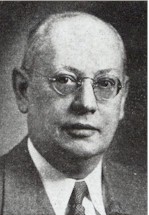Charles F. Wagner: Difference between revisions
No edit summary |
No edit summary |
||
| (5 intermediate revisions by 2 users not shown) | |||
| Line 1: | Line 1: | ||
{{Biography | |||
|Image=Charles F. Wagner.jpg | |||
== | |Birthdate=1895/03/20 | ||
|Birthplace=Pittsburgh, PA, USA | |||
|Associated organizations=[[Westinghouse Electric Corporation]] | |||
|Fields of study=Power | |||
|Awards=George Montefiore Prize of Belgium; AIEE Edison Medal | |||
}} | |||
Charles F. Wagner was born in Pittsburgh, PA, on 20 March 1895. He received the B.S. degree from Carnegie Institute of Technology, Pittsburgh, PA, in 1917, and did one year of graduate work at the University of Chicago, IL. | Charles F. Wagner was born in Pittsburgh, PA, on 20 March 1895. He received the B.S. degree from Carnegie Institute of Technology, Pittsburgh, PA, in 1917, and did one year of graduate work at the University of Chicago, IL. | ||
In 1918, he joined the Westinghouse Electric Corporation, East Pittsburgh, PA. While at Westinghouse, he served as manager of central station engineering at East Pittsburgh, among other roles. Much of his research and development work concerned measuring and managing lightning strikes on power lines. In 1939, along with Gilbert D. McCann, he developed a fulchronograph, which measured both the magnitude of current and time in a lightning bolt. As the New York Times reported on July 16 of that year: It was the “first time that an arrester had been deliberately placed in the path of a direct lightning stroke and successfully rebuffed it, while the bombardment was analyzed by a device sensitive enough not only to record the maximum current of the stroke but also to chart its complete wave shape.” | In 1918, he joined the Westinghouse Electric Corporation, East Pittsburgh, PA. While at Westinghouse, he served as manager of central station engineering at East Pittsburgh, among other roles. Much of his research and development work concerned measuring and managing lightning strikes on power lines. In 1939, along with Gilbert D. McCann, he developed a fulchronograph, which measured both the magnitude of current and time in a lightning bolt. As the New York Times reported on July 16 of that year: It was the “first time that an arrester had been deliberately placed in the path of a direct lightning stroke and successfully rebuffed it, while the bombardment was analyzed by a device sensitive enough not only to record the maximum current of the stroke but also to chart its complete wave shape.” | ||
Wagner was active on national and international technical and standardizing committees in the American Institute of Electrical Engineers (AIEE), the National Electrical Manufacturers Association (NEMA), the American Standards Association (ASA), the International Electrotechnical Commission (IEC), and the International Conference on Large Electric High-Tension Systems (CIGPE). | |||
Wagner | With his collaborator, R. D. Evans, Wagner won the George Montefiore Prize of Belgium in 1929. He received the honorary degree of Doctor of Engineering from the Illinois Institute of Technology, the Westinghouse Order of Merit, and was named "Standards Personality of the Month" by ASA. He was a Professional Engineer in the State of Pennsylvania; a member of Tau Beta Pi and Sigma Xi; and an Eminent Member of [[Frederick Terman and Eta Kappa Nu|Eta Kappa Nu]]. In 1951 Wagner was awarded the [[IEEE Edison Medal|AIEE Edison Medal]], "For his distinguished contributions in the field of power system engineering." | ||
[[Category:People and organizations]] [[Category:Engineers]] [[Category:Energy]] [[Category:Power systems]] [[Category:IEEE]] [[Category:Geographical units]] [[Category:Societies]] [[Category:Standardization]] | |||
{{DEFAULTSORT:Wagner}} | |||
Latest revision as of 16:44, 20 January 2016
- Birthdate
- 1895/03/20
- Birthplace
- Pittsburgh, PA, USA
- Associated organizations
- Westinghouse Electric Corporation
- Fields of study
- Power
- Awards
- George Montefiore Prize of Belgium, AIEE Edison Medal
Biography
Charles F. Wagner was born in Pittsburgh, PA, on 20 March 1895. He received the B.S. degree from Carnegie Institute of Technology, Pittsburgh, PA, in 1917, and did one year of graduate work at the University of Chicago, IL.
In 1918, he joined the Westinghouse Electric Corporation, East Pittsburgh, PA. While at Westinghouse, he served as manager of central station engineering at East Pittsburgh, among other roles. Much of his research and development work concerned measuring and managing lightning strikes on power lines. In 1939, along with Gilbert D. McCann, he developed a fulchronograph, which measured both the magnitude of current and time in a lightning bolt. As the New York Times reported on July 16 of that year: It was the “first time that an arrester had been deliberately placed in the path of a direct lightning stroke and successfully rebuffed it, while the bombardment was analyzed by a device sensitive enough not only to record the maximum current of the stroke but also to chart its complete wave shape.”
Wagner was active on national and international technical and standardizing committees in the American Institute of Electrical Engineers (AIEE), the National Electrical Manufacturers Association (NEMA), the American Standards Association (ASA), the International Electrotechnical Commission (IEC), and the International Conference on Large Electric High-Tension Systems (CIGPE).
With his collaborator, R. D. Evans, Wagner won the George Montefiore Prize of Belgium in 1929. He received the honorary degree of Doctor of Engineering from the Illinois Institute of Technology, the Westinghouse Order of Merit, and was named "Standards Personality of the Month" by ASA. He was a Professional Engineer in the State of Pennsylvania; a member of Tau Beta Pi and Sigma Xi; and an Eminent Member of Eta Kappa Nu. In 1951 Wagner was awarded the AIEE Edison Medal, "For his distinguished contributions in the field of power system engineering."
